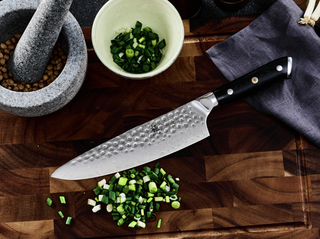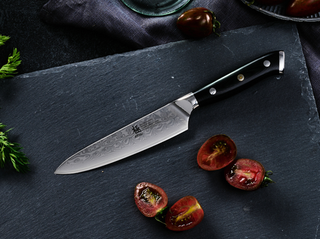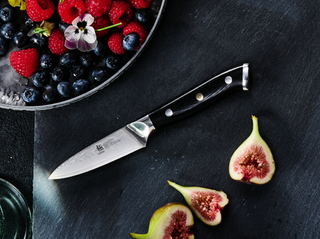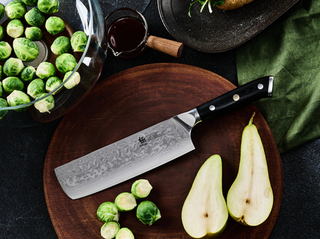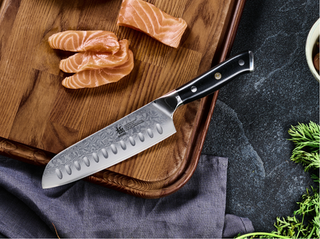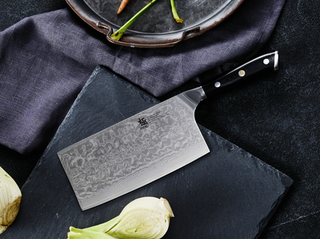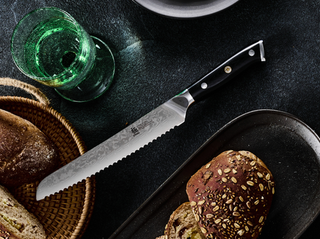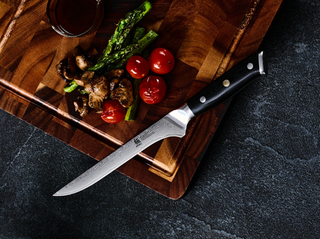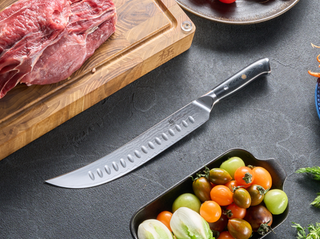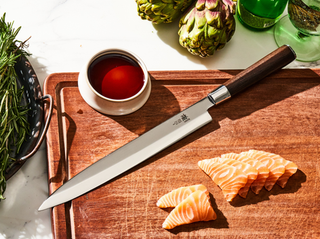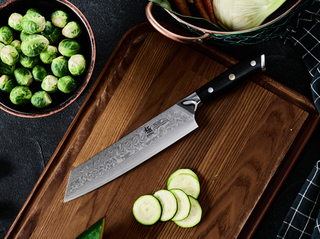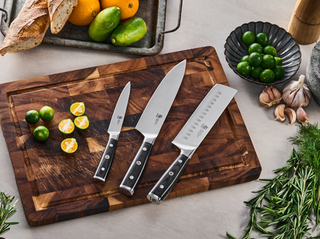 One of the most important precautions to take when buying a cutting board is to ensure that it is non-toxic. Over a third of Americans have reported that the prevalence of chemicals in food is a major concern, and toxic cutting boards are one way microplastics and other harmful chemicals can end up in food during the cooking process.
One of the most important precautions to take when buying a cutting board is to ensure that it is non-toxic. Over a third of Americans have reported that the prevalence of chemicals in food is a major concern, and toxic cutting boards are one way microplastics and other harmful chemicals can end up in food during the cooking process.
So, how do you choose the best cutting board to guarantee your food safety, and by extension, your overall health?
Choosing the best non-toxic cutting board all comes down to understanding different cutting board materials and what food safety risks they could potentially pose.
The truth is, some cutting board materials are safer than others, and when you understand the different risks posed by different kinds of cutting board materials, it becomes easy to tell the best non-toxic cutting boards apart.
Main Points
- Hardwood cutting boards are the best non-toxic cutting boards, especially when they are not made with any glues or finishes.
- Titanium cutting boards and tempered glass cutting boards are also non-toxic options that work.
- When choosing a wooden cutting board, go for hardwood: teak, maple, cherry and walnut are all good choices
- Glass cutting boards are non-toxic, but may not be suitable for heavy use
- As much as you can, stay away from plastic cutting boards.
- Stone and marble cutting boards are also considered non-toxic, but they pose a risk to your knives as well.

1. Choosing a Non-Toxic Cutting Board: Understand Cutting Board Materials
The difference between a toxic cutting board and a non-toxic cutting board is the material it is made of. Overall, three types of cutting boards are generally considered to be the most non-toxic: solid hardwood cutting boards, titanium cutting boards, and tempered glass cutting boards.
- Solid hardwood is the most non-toxic material for a cutting board.
- Titanium cutting boards and tempered glass cutting boards are also non-toxic, but using them (especially glass cutting boards) may be detrimental to your kitchen knives.
Top 3 Best Non-Toxic Cutting Boards Ranked
i. Solid hardwood cutting boards
Cutting boards made of hardwood, especially maple, walnut, cherry, and teak, are the best non-toxic cutting boards you can get for your kitchen. These woods are naturally antimicrobial and are gentle on knives.
For the best non-toxic cutting board, look for a hardwood cutting board that is a single slab and does not have any glues or finishes. This is usually an indicator that it has not been manufactured with any dangerous chemicals.
ii. Titanium Cutting Boards
Titanium is also a great material from which non-toxic cutting boards are made. Titanium cutting boards are non-porous, non-reactive, and highly resistant to bacteria. This makes them the second most non-toxic cutting boards. In addition, they are gentle on knives and do not require sealing or conditioning.
iii. Tempered Glass Cutting Boards
Tempered glass cutting boards are non-porous and easy to clean. However, they are not as non-toxic as titanium or hardwood cutting boards because they can be harsh on knives and also tend to chip over time. However, used for light tasks or serving trays, tempered glass cutting boards are a good non-toxic option.
2. Choosing a Non-Toxic Wooden Cutting Board.
Wood cutting boards are generally very safe and non-toxic. The non-toxicity of wood cutting boards stems from the fact that trees naturally fight bacteria growth on their own.
- Trees have antimicrobial properties that help them fight of bacteria, and in turn make wood the ideal material from which to make a non-toxic cutting board.
- In addition, wood cutting boards are very safe and healthy to use: they don't dull your knives, and with proper care, they can last for years.
What Are The Most Non-Toxic Wooden Cutting Boards?
If you decide to go with a wood cutting board, it is important to understand that not all wood cutting boards are equally non-toxic. The most non-toxic wooden cutting boards are made of hardwoods like teak, maple, walnut, and cherry.
Teak stands out from the crowd. Its natural oils do more than just make it look good – they help prevent bacterial growth and resist moisture damage. While other woods need frequent oiling to stay in shape, teak's built-in oils mean less maintenance for you.
Other solid options include maple, known for its durability and knife-friendly surface, and walnut, which combines strength with natural beauty. Both will serve you well in a busy kitchen.
- Maple: Perfect for heavy-duty work with cleaver knives
- Walnut: Ideal for precise cuts with Japanese knife sets
- Oak: Great for work with butcher knives
- Bamboo: Sustainable option for everyday use
- Teak: Premium choice for serious home chefs
For top-tier non-toxic cutting boards, I recommend Kyoku’s End Grand Teak Wood Cutting Board.
This 2-inch thick kitchen essential combines professional-grade durability with smart features like built-in ingredient holders and a wide juice groove, all while protecting your knives with its premium end grain construction. It's where timeless craftsmanship meets modern functionality.
3. Understand That Some Non-Toxic Cutting Board Materials Might Harm Your Knives
It is important to realize that a cutting board being non-toxic doesn't automatically make it ideal for your kitchen. Some non-toxic cutting boards are made of materials that may dull your knives if the contact is too strong.
Take glass cutting boards, for example: they are non-toxic, pretty, and super easy to clean. But if you've just invested in a nice Santoku knife or Japanese chef knife, you might not want to use it on a glass cutting board, even if it is non-toxic.
Here's what you need to know about some common cutting board materials:
The Problem with Glass Cutting Boards
While tempered glass cutting boards are generally pretty non-toxic, they have to be used with caution. Slide your Santoku knife across a low-quality glass chopping board, and you'll hear the painful screech of your blade losing its edge. Glass boards might be pretty, but they have been known to dull blades relatively easily.
The Problem with Plastic Cutting Board
Remember when plastic boards seemed like the perfect solution? Turns out, there's a catch. Those knife marks aren't just ugly – they're tiny homes for bacteria. Worse yet, every cut releases microscopic plastic bits into your food. Best stay away from them.
Stone and Marble: Save These for Your Pastries
Stone and marble are also great as non-toxic cutting boards. But, while they are perfect for rolling pie dough, they are terrible for your Japanese chef's knife. Except that they are of exceptionally high quality, they are likely to chip or dull the edge of your knife. You may want to avoid these, too.
4. Cutting Board Materials Chart
|
Material |
Food Safety |
Knife Friendliness |
Longevity |
Best For |
|
End-Grain Teak |
Excellent - Natural antibacterial properties, non-toxic |
Excellent - Self-healing surface |
10+ years with proper care |
Daily use, premium kitchens |
|
Maple |
Excellent - Natural antibacterial properties, non-toxic |
Excellent - Soft on knife edges |
5-10 years with proper care |
Everyday cooking, meat preparation |
|
Walnut |
Excellent - Natural antibacterial properties, non-toxic |
Excellent - Very gentle on knives |
5-10 years with proper care |
Precision cutting, Japanese knives |
|
Bamboo |
Good - Natural properties, but check adhesives |
Good - Harder than maple, may dull knives faster |
3-5 years |
Eco-conscious kitchens, light prep |
|
Natural Rubber |
Very Good - Non-porous, resists bacteria |
Very Good - Gentle on edges |
3-5 years, can be resurfaced |
Professional kitchens, raw meat |
|
Plastic |
Poor - Harbors bacteria in cuts, releases microplastics |
Fair - Initially good, deteriorates with use |
1-2 years before significant scarring |
Not recommended for frequent use |
|
Glass |
Good - Non-porous, no chemical leaching |
Poor - Extremely damaging to knives |
Many years if not broken |
Serving only, not cutting |
|
Marble/Stone |
Good - Non-porous, no chemical leaching |
Very Poor - Destroys knife edges |
Lifetime if not chipped |
Pastry work, serving only |
As you can see, natural wood boards like teak and maple offer the best combination of food safety, knife protection, and longevity—making them the healthiest choice for your everyday cooking needs.
5. Why Your Cutting Board Choice Matters
Your cutting board does more than just protect your countertop. It's the surface where raw ingredients become your next meal. And here's what makes this important: studies have shown that cutting surfaces can transfer unwanted substances into your food during prep.
Hidden Risks in Common Cutting Boards
Most people don't realize their cutting boards might harbor unsafe materials:
- Plastic cutting boards release microplastics as they wear down
- Certain wood composites contain formaldehyde-based adhesives
- Many antibacterial surfaces use triclosan, a controversial chemical
- Some bamboo boards utilize questionable binding materials
Quick Safety Check: Is Your Current Board Safe?
Take a look at your cutting board. Do you notice any of these warning signs?
✗ Deep knife scratches that trap food
✗ A chemical smell, especially when wet
✗ Flaking or peeling surface
✗ Unclear material composition
✗ Labels claiming "antibacterial properties"
If you spotted any of these red flags, it's time to consider an upgrade to something safer. The good news? Safe alternatives don't have to break the bank.
Benefits of Non-Toxic Cutting Boards
Switching to a safe cutting board offers several advantages:
✓ Food remains free from chemical contamination
✓ Natural antimicrobial properties (in specific materials)
✓ Enhanced food preparation safety
✓ Sustainable kitchen investment
Safe food preparation starts with choosing the right tools. A non-toxic cutting board is the foundation for healthy cooking. In the following sections, we'll explore the safest materials for cutting boards and help you make an informed choice for your kitchen.
6. What Your Knives Are Trying to Tell You
Watch any pro chef at work. Notice how they never use glass or stone boards? There's science behind their choice, and it all comes down to how your knife interacts with the cutting surface.

Is a Wood Cutting Board Good For Knives?
Wood boards have a secret superpower: micro-compression. When your Nakiri knife hits the surface, the wood fibers give just enough – like landing on a gym mat instead of pavement. This tiny flex:
- Keeps your blade sharpe longer
- Makes precise cuts easier
- Prevents edge rolling
- Reduces the force needed to cut
Matching Your Board to Your Knife
Different knives have different personalities. Here's how to make them happy:
Japanese Knives (including your fancy Japanese knife set) love softer woods that respect their precisely honed edges. Think of it as providing a proper stage for a master performer.
The Cleaver Knife needs a sturdy partner. End-grain wood boards absorb impact like a boxer taking a punch – they can handle the force while protecting the blade.
The Boning Knife requires a surface that stays put. Quality wood gives you control without fighting back, letting you focus on those precise cuts.
Your Best Steak Knives: They'll stay sharper months longer on wood versus plastic or glass. Think of wood as a natural knife spa – it keeps them refreshed and ready.

7. How to Keep Your Wood Cutting Board Safe with Mineral Oil
Even the safest wood cutting board needs protection. That gorgeous teak or maple board you just bought? It's naturally non-toxic, but it needs a barrier between your food and the raw wood. That's where food-grade mineral oil comes in.
In case you were curious about what makes mineral oil food-safe? Check out our complete guide to “What Is Food Grade Mineral Oil?”.
The Right Way to Oil Your Cutting Board
First-Time Treatment: Your new board is thirsty. Give it a proper start:
- Apply oil daily for the first week
- Let each coat soak in completely
- Watch how the wood's color deepens – that's protection building up
Ongoing Protection. Keep that non-toxic surface sealed:
- Regular use: Monthly oiling keeps it safe
- Heavy use: Every two weeks
- Professional kitchen level: Weekly care
Pro Tip: When choosing mineral oil, look for "food-grade" or "USP-grade" on the label. The cheap stuff from the hardware store? That's not what you want near your food prep surface.
Regular oiling does more than protect your board – it ensures safe food prep for years to come. Whether you're using a Japanese knife set or your trusty butcher knife, this simple step makes all the difference.
8. Common Questions About Non toxic Cutting Board
"Are rubber cutting boards toxic?"
Natural rubber cutting boards are non-toxic and safe for food preparation.
- Look for boards made with food-grade natural rubber without BPA, phthalates, or other harmful additives.
- Avoid synthetic rubber boards with unknown composition or strong chemical odors.
"What is the best cutting board surface for overall health?"
End-grain hardwood (particularly teak, maple, or walnut) provides the healthiest cutting surface. These materials have natural antibacterial properties that help prevent cross-contamination, don't release microplastics into your food, and are gentle on your knives—keeping metal particles from entering your food.
"What makes a cutting board non-toxic?"
A truly non-toxic cutting board is made from materials that don't leach harmful chemicals into food and don't harbor bacteria. The board should be:
- Free from formaldehyde-based glues and adhesives
- Made without added antimicrobial chemicals like triclosan
- Constructed of food-safe materials throughout (not just coated)
- Designed without components that can shed particles into food
Natural materials like solid hardwood and food-grade natural rubber meet these criteria, while many plastic, bamboo composite, and treated boards do not.
"Are there organic cutting boards available?"
While cutting boards aren't typically certified organic like food products, you can find boards made from sustainably harvested wood that's grown without pesticides.
Look for boards with FSC certification (Forest Stewardship Council) which ensures sustainable forestry practices. Some specialty manufacturers offer cutting boards made from trees grown in organic operations, though these are specialty items and generally carry premium prices.
"What's the healthiest cutting board for a family kitchen?"
For families, especially those with children, the healthiest option is an end-grain hardwood cutting board made without harmful adhesives.
These boards don't release microplastics or chemicals into food, naturally resist bacteria, and stay sanitary with proper cleaning. Having multiple boards—a main hardwood board for vegetables and general prep, plus a dedicated board for raw meat—creates the safest food preparation system for your family's health.
9. Conclusion
Your cutting board touches every ingredient that goes into your meals. Why not make sure it's safe?
The path to safer food prep is clear:
- Choose natural wood boards over synthetic materials
- Pick quality woods like teak, maple, or walnut
- Protect your board with food-grade mineral oil
- Skip anything chemically-treated or plastic
The right cutting board does more than protect your countertop – it keeps your food truly safe. Make the switch to natural wood, and taste the difference that comes with worry-free cooking.
